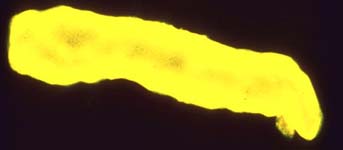Waxy casts
Clinical relevance
Waxy casts consist of plasma proteins. Their observation is always accompanied by a significant proteinuria. They are found in diabetic kidney disease, nephrotic syndrome, and chronic diseases of the renal parenchyma.
Origin

The casts are waxy and consist mainly of plasma proteins. Their mucoprotein component is very low.
Identification
Waxy casts are easy to recognize with brightfield microscopy. They have the highest refractive index of all casts and their extremities are broken or round. This is probably due to their high density, which makes them more fragile and more brittle than other casts. Their structure is smooth and homogeneous. They are yellowish like wax. Their diameter is often quite large, with well-defined and sometimes jagged edges indicating that they were probably formed in the collecting duct. The waxy casts rarely contain cellular inclusions.


Waxy cast: bright field microscope (left), fluoresecence microscope (right)